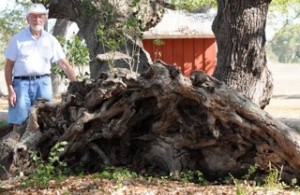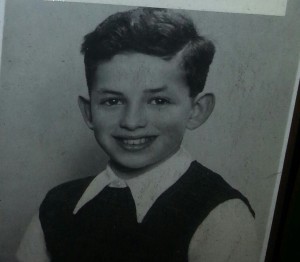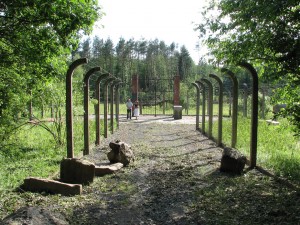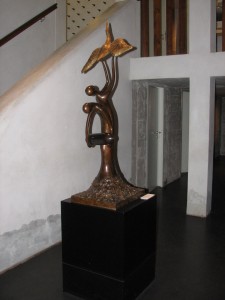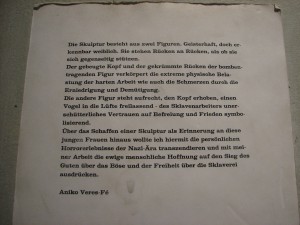Here you will find occasional posts and updates about my work and related subjects.
Baby it’s cold outside
This morning I received an email from Clare’s childhood sweetheart and lifelong friend Tibby Weston of Texas who helped me in my research for The Violinist. Now in his 90s, Tibby has written about his own life as a Holocaust survivor in his autobiography The Vision (Xlibris Corp 2002) and continues to write on related issues. He tells me, ‘I am, as Clare was and most survivors are, a little bit insane. There is a lot of material on this issue on the Internet. One report, however, found that those survivors who wrote a book about their experiences belong to the 8% who show no significant PTDS symptoms. I am attaching my newsletter from January, when it was winter here. I hope you’ll like it.’
I do like it, and share it here:
You hear about veterans of the war in Iraq and Afghanistan who are suffering from PTSD in surprisingly large numbers. What you don’t hear about is that of World War 2 veterans and Holocaust survivors experiencing a massive re-occurrence of PTSD with the advance of old age.
Elderly Holocaust survivors show a high simultaneous presence of chronic PTSD (91.8%), with psychotic disorders more than 50 years after the experience of the massive psychic trauma of the Holocaust.
The occurrence of chronic PTSD of such magnitude is significantly higher among Holocaust survivors than the rate reported for war veterans, which is less than 45%. This difference may be related to the unique nature of the Holocaust trauma, combining dehumanization, confrontation with death, and massive loss for a prolonged period. The exposure to such trauma puts into effect mechanisms to deal with traumatic memory and its psychic repercussions.
The weather in Europe during the winter of 1944-45 was some of the worst ever recorded in the 20th century with the temperature going below zero on the Fahrenheit scale. At Christmas, the Hungarian capital was surrounded, so that hundreds of thousands of civilians as well as German and Hungarian soldiers were trapped in the besieged city.
I was lucky that suffering from typhoid fever in the spring of 1945 wiped out most of my memory of the trauma of the winter of 1944-45. I am, however, experiencing a gradual return of memories of the traumatic experiences and I am less and less able to successfully hide or mask such memories.
Experts discovered that survivors of traumatic events could overcome debilitating psychosis and PTSD through “historicizing” their memories by facing them and writing about them. Among Holocaust survivors these amount to about 8%. In contrast, other psychotic survivors are unable to reach this calm state of balance and for them memory is a lifelong burden.
I am now faced with the dilemma of writing about recurring memories and thus prevent developing possible debilitating old age PTSD, or trusting my defense mechanism that made it possible to reach old age without burdening the world with memories that are best left untold.
Today’s world has its own horrors. Millions are in refugee camps fighting for bare survival, genocide is rampant, and billions have no access to minimum civilized standards of life. Looking at the past from the bird’s eye view of nine decades, there is really no good reason to dwell on the past horrors. History keeps repeating itself. I fervently hope that our loved ones be spared PTSD and the recurring thereof.
For the thousands of veterans, however, there is hope. Learn from the experience of Holocaust survivors. Perhaps someone somewhere will start a movement to assist today’s veterans to “historicize” their traumatic memories. It will help them mobilize effective skills for coping and adapting to social roles and prevent recurring PTSD at advancing old age. Perhaps some college, or university could establish courses in writing memoirs as a patriotic undertaking to assist veterans of recent wars.
As to myself I have a plan. Survive the cold and soon it will be spring with memories of winters gone. The red bud trees will bloom, the humming birds will buzz by again and the exciting signs of rebirth and new beginnings will wipe out memories of the winter, and all the winters before.
P.S. IT IS SPRING! HALLELUJAH!
St Matthew’s Collegiate School Centenary
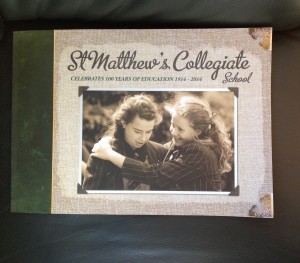 Congratulations to St Matthew’s Collegiate School in Masterton, which this year celebrates 100 years of education. I had a happy Form II year there half a century ago. To anyone stumbling on this site who remembers me (Sarah Greville) I’d love to hear from you. I’d especially love to hear from my English teacher, Miss Bragg (Robyn?), to thank her. She’s one of many reasons why I’m grateful for my year at St Matthew’s. I was therefore delighted to be asked to write four essays for the book that was launched at the beginning of the weekend’s celebrations. I explained it to the launch gathering as follows:
Congratulations to St Matthew’s Collegiate School in Masterton, which this year celebrates 100 years of education. I had a happy Form II year there half a century ago. To anyone stumbling on this site who remembers me (Sarah Greville) I’d love to hear from you. I’d especially love to hear from my English teacher, Miss Bragg (Robyn?), to thank her. She’s one of many reasons why I’m grateful for my year at St Matthew’s. I was therefore delighted to be asked to write four essays for the book that was launched at the beginning of the weekend’s celebrations. I explained it to the launch gathering as follows:
For my first piece, about how the school began, I depended largely on the school archives, but I was able to add insights about the first headmistress, Evelyn Whitehead, and her sister Yetti, by talking to their relatives, including Yetti’s daughter, Kathleen Bell, now in her 90s, and Evelyn’s granddaughter, Barbara Simons. I was very taken with Evelyn and Yetti, who were both university educated in Dunedin, which was then the most progressive city in the country regarding women’s education – very different from Masterton. Aged just 24 and 21, they came here in 1914 to start St Matthew’s. They brought high ideals, and an attitude that girls can do anything.
Helen Dashfield’s comprehensive history of St Matthew’s, To the Stars published at the 75th anniversary in 1989, fills big gap between the beginning and my second narrative, which is on Senior College in the 1980s. Helen herself is an important figure in this, and in the story on integration. These were turbulent times and interesting for me to research. Others echoed Erik Pedersen’s recollection that it was a hellish period.
I interviewed many people about this decade. I haven’t referred to them all but they all helped me get a better understanding of the subject. I also waded through volumes of documents to get an overall picture that included Rathkeale and Hadlow, but my account is from St Matthew’s point of view and I don’t apologise for that bias. Ultimately it’s a triumphant story. Some of you have mothers and grandmothers who played their part as pupils, parents, teachers and old girls.
Lastly my final piece brings me to you today. I asked about the changes in society that are in turn changing school life, and I heard about the digital revolution. It seemed strange in the light of 100 years when the school struggled with two world wars, economic depression, free-falling pupil rolls and near bankruptcy that today the focus should fall on the mobile phone, but it’s a huge issue.
This isn’t specific to St Matthew’s but how it and other issues of today are dealt with at St Matthew’s are specific, reflecting the school’s Special Character as defined in the Integration Agreement. And that goes right back to the core principles Evelyn Whitehead and her sister Yetti brought to the school in 1914.
That’s one way of looking at it. The rest of the book, compiled by Jan Pedersen (Bowie) and Sue Franck (Bowie) is packed with photos, samples of writing and a timeline, telling many other stories.
For more about centennial projects, click on centenary.
Kelemen Quartet dedication
As part of the New Zealand Festival, Chamber Music New Zealand presented the Kelemen Quartet last night in a concert dedicated to the memories of two fine Wellington musicians who died last month, pianist Judith Clark and especially to violinist Clare Galambos Winter.
This programme that included Kodály and Bartók, played with such virtuosity and feeling by young Hungarian musicians, would have stirred Clare’s own feelings about being Hungarian. She recalled in the 1950s an early occasion of playing a Kodály work with the New Zealand National Orchestra (later the NZSO) when conductor John Hopkins turned to her and asked, ‘Did we get it right, Clare?’ After playing something by Bartók, which was more painful, Hopkins asked her how she felt. She told me, ‘I felt the suffering in the music very deeply. It drove right to the bottom of my soul.’
For a glimpse of Clare playing with the first violins of the NZSO in 1980, see http://youtu.be/8YzIHZyObgk
Clare’s obituary
My obituary for the Dominion Post was published on Saturday 1 March. See http://www.stuff.co.nz/dominion-post/news/obituaries/9783722/Music-helped-violinist-survive-the-horrors
‘The Violinist’ back in print
I have just picked up my new copies of The Violinist which should be available at all good bookshops and online at http://vup.victoria.ac.nz/the-violinist-clare-galambos-winter/
Mihály Galambos, 1929–1944
One of the buttons collected for the New Zealand Children’s Holocaust Memorial project was given by Clare Galambos Winter for her brother, Mihály, whom she called Mishu. Aged fourteen, Mihály was murdered at Auschwitz-Birkenau on 7 July 1944. Clare’s death this week at the age of 90 leads to reflection about this other life unlived, extinguished in its flush of youth.
How did Clare, the survivor, live with this knowledge? Initially with total disbelief. In fact she never completely accepted Mihály’s death, and it didn’t help her to wonder if he might still be alive somewhere, perhaps in the Soviet Union. So there was no closure. She asked me when I returned from my research trip to Europe in 2008, had I found any records of him and her mother? No, by July 1944 the German’s meticulous record-keeping system had broken down, so great were the numbers arriving daily at Auschwitz-Birkenau. Those selected for potential slave labour were sent in one direction, the rest in another that led to the gas chamber that day. They included children under sixteen. Mihály at fourteen was too young to live.
When she thought of Mihály, Clare would simply say ‘How could they?’ to which there was no answer. Having suppressed her memories for so long, she couldn’t remember her brother clearly, which added to her loss. What did they do together? What did they talk about? She tried to recall him in their last weeks together in the ghetto, where they lived in such close confinement, or on the terrible train journey to Auschwitz, but these memories had been buried too deep to surface at will. She recalled a bright athletic boy with an enquiring mind, a fascination for the unknown and a sense of humour. He played the accordion, which she said suited his personality. She kept his photo by her bed until she died.
Sarah Gaitanos
15 February 2014
Written for the New Zealand Children’s Holocaust Memorial website, honouring a promise Vera Egermayer made to Clare shortly before Clare died.
Tribute to Clare
The last time I saw Clare, ten days before she died, I wished for her the quick and gentle release she wanted, for living was becoming too hard. If the end came more quickly than I expected, it was as she wished.
Over the last weeks she had enjoyed public and private tributes. In a special ceremony, Victoria University of Wellington gave her the honour of making her a Hunter Fellow in December, the Jewish community had held a special occasion for her, and she shared with friends a heart-warming celebration of her life on her 90th birthday, held in style at her home.
As no Jewish venue was big enough to hold the numbers expected to attend her funeral yesterday, it was held at Old St Paul’s. People from her many walks of life, including former colleagues from the NZSO, came to farewell her in a service led by Rabbi Adi Cohen of the Wellington Progressive Jewish Congregation. I was honoured to be asked to speak. Here below is my tribute.
Tribute to Clare at her funeral at Old St Paul’s, Thursday 13 February 2014
Clare had the gift of making people feel special to her – many of you will know this – and I certainly felt that my relationship with Clare was very special, not only as her biographer but as a friend.
I am going to talk about Clare’s experiences of the Holocaust, and as a Holocaust survivor.
Klári Galambos and her family were victims of antisemitism before the German occupation of Hungary, but their lives were relatively safe. Aged 20, in her final year of her violin studies in Budapest, Klári had all the normal hopes and dreams of a young woman, and also she had ambitions for her future career as a violinist. Everything changed from 19 March 1944, when the German tanks entered Budapest.
Over the following months she would lose her family, her home, possessions, most painfully, her violin; also any sense of dignity, self-worth, individuality, all basic freedoms and human rights. She said, ‘We lost the value of everything and became non-persons. We were alimentary tracks. The only thing we could think of was what we were going to eat and how to eliminate it.’ Then followed a slow recovery to feeling human again, and it’s a measure of her strength of character that Clare eventually embraced life, experienced love and joy, and gratitude for the new life she found in New Zealand.
My work with Clare started with recovering memories of her family, and herself as a girl and a young woman. It could have been painful, I’m sure it was, but it was also a release to talking about her childhood, especially her mother. She hadn’t allowed herself to think about her mother for so long. After one of our sessions she dreamt of her mother for the first time, and awoke feeling comforted.
I was concerned about recovering memories that were better left dormant. It’s a further measure of Clare’s character and courage that that she told me I could ask her anything.
Her initiation to what she referred to as ‘the horrors’ came soon after the German occupation when she was thrown into a jail in Budapest for three days. That she and others should be herded and locked up, simply because they were Jews, treated like animals with standing room only and no sanitation, expecting to be shot, was all the more shocking to her because at that stage she still had all her sensitivities.
She was released and managed to get home to her family in Szombathely On 14 May the Jews of Szombathely were thrown out of their homes and locked in the ghetto. Clare’s recollection of this was foggy, except for a flash of memory of the family being evicted from their home. In a passing glimpse into her parents’ bedroom, she saw the rough hand of a thug rummaging among her mother’s linen in her wardrobe. He pulled out Klári’s precious toy, a donkey with its stuffing coming out. She had loved that donkey, and until that moment she hadn’t known her mother had kept it. This poignant memory, which says so much, foreshadows the brutality that was to come.
The Jews had to hand in all valuable possessions, but Klári had permission to keep her violin. Then, after nearly two months in the ghetto, when they were boarding the cattle trucks to Auschwitz, willingly because they thought they were leaving a hellhole for a better place in Germany, one of the guards took her violin from her, saying ‘You won’t need this where you’re going.’ It was like losing her right arm, and it hurt her more than anything, even more than saying goodbye to her father, Andor Galambos, when he was sent to a labour camp, because she didn’t know she’d never see him again. He died in Bergen-Belsen.
The next parting was at the ramp at Auschwitz-Birkenau, where Klári and her aunt Rózsi were separated from her brother Mihály and her mother Zsuzsanna. By this time, after the horrifying journey, Klári thought only of her hunger and thirst. When she later asked about where her mother and brother were, she was told they were burned in the gas chamber. Of course she didn’t believe this. Mihály was aged 14, Zsuzsanna 45.
Rózsi then became her whole family. Their captivity in Auschwitz-Birkenau was relatively short, but the conditions of the part of the camp where they were interred, Birkenau III, called ‘Mexico’, were such that few survived. Klári knew that to survive, they had to get out, and the only way was to be selected for slave labour in Germany. On the third selection they were successful and sent to a munitions factory at Allendorf.
After Auschwitz, Allendorf was like paradise, and Klári recovered some of her humanity, until winter came, the food ran out and all the prisoners suffered from toxic poisoning from handling chemicals and breathing poisonous fumes. But the war was ending and the Americans arrived in time for Klári. Many of you will have heard her describe her last days before liberation and her emotional realisation that she was free.
She then had to come to terms with what she had lost, where she could live and how. She and Rózsi returned to Hungary to find none of their immediate family had survived. When the opportunity to emigrate to New Zealand arose, they grabbed it and came in 1949. In New Zealand Clare, as she now called herself, wasn’t confronted by the past, and she had Rózsi. She determined to build a new life, which she did through music. Recalling her first rehearsal with the National Orchestra, she said,
‘I opened the music and it was Beethoven’s Fifth Symphony, and it was somehow as if I were in a dark room and suddenly the window was opened and there was brilliant sunshine outside. … I thought, Oh yes, I’m home. I’m home.’
Through music she could escape her past, or she could express her sorrows without having to name or define them. All that she had experienced remained part of her, somewhere deep inside.
Clare’s need for security and her hunger for love and for family were also met in New Zealand, through her marriages to cellist Karl Kallhagen and Dr Otto Winter, also through Carol McKenzie and her family, her other colleagues in the NZSO, and her circles of friends that widened in her retirement. To the end she was cared for and cherished by devoted friends, and that, she said, made life worth living.
We have lost our friend, but she touched us, opened our eyes and enriched our lives in ways that we will never forget.
Clare Galambos Winter, 1923 – 2014
Clare died peacefully yesterday morning at the Mary Potter Hospice. I mourn her parting and my thoughts go out to those who lovingly cared for her on a daily basis. Her funeral is to be tomorrow morning at ten o’clock at Old St Paul’s. I will update this post in the days ahead.
Memorial to victims of Münchmühle concentration camp
This week the Documentation and Information Centre (DIZ), at Stadtallendorf in Germany, opened an exhibition commemorating 25 years of the memorial site to Münchmühle.
This was the camp to which Clare Galambos Winter was sent from Auschwitz in August 1944, one of 1000 women, mostly Hungarian Jews, to provide slave labour in the munitions factories.
In The Violinist I have described their arrival:
Continuing their journey into Hesse, they arrived on 19 August at their destination, a village called Allendorf. To their surprise, they saw no grey rubble or any sign of war, but rather, neat houses and flower gardens. The trees were red and gold which was unusual in August, but they thought little of that as they walked a few kilometres through a ‘gorgeous’ pine forest to a small camp. Here too, flowers had been planted. It seemed like a dream.
Named Münchmühle after the nearby mill, their new camp had been converted from a forced labour camp to a concentration camp by surrounding it with a three-metre barbed-wire fence. Its new inmates noticed that it wasn’t electrified. The wooden huts had dry wooden floors and bunks. ‘On each bunk was a thin grey blanket … One light bulb hung in the middle of the ceiling. We felt as if we had landed in the Ritz.’
It was infinitely better than Auschwitz, but, as they soon realised, it was to be no holiday camp.
I visited Stadtallendorf in 2008 as part of my research for The Violinist. The help I received there from Fritz Brinkmann-Frisch and Lydia Hartleben at the Documentation and Information Centre (DIZ) was invaluable to my research for this important chapter.
Sir Nicholas Winton to be Patron of New Zealand Children’s Holocaust Memorial
News from Vera Egermayer, former Honorary Consul of New Zealand to the Czech Republic, child survivor of Terezin, now leading project to build Children’s Holocaust Memorial in New Zealand – made of 1.5 million buttons each representing the life of one Jewish child lost in the Holocaust.
‘I have just had confirmation from his daughter that Sir Nicholas Winton will be honoured to be a patron of the New Zealand Children’s Holocaust Memorial. Having the support of Nicky Winton who has made such an outstanding contribution to humanity strengthens our resolve to get the Memorial built.’
Sir Nicholas’s nomination for the Nobel Peace Prize again this year received world-wide media coverage and was broadcast repeatedly on radio New Zealand.
Nicholas Winton will celebrate his 104th birthday on 19 May at his home in Maidenhead, England. His patronage of the New Zealand Children’s Holocaust Memorial will be part of the celebrations. Vera Egermayer has accepted the family’s invitation to attend.
from Vera Egermayer
Project Leader
New Zealand Children Holocaust Memorial
The project is under the auspices of The Holocaust Centre of |New Zealand (www.holocaustcentre.org.nz)
